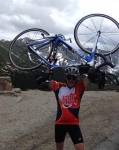jnk wrote:Can anyone here explain the following to me (from the article Muffy linked to earlier in the thread)? Is this implying that all the units have the same basic line in the sand that ResMed keeps getting picked on for having? (Colorization is mine.)
Resmed does not get picked on. It has been stated time and again -- by "-SWS" for instance -- that
all algorithms have a line in the sand.
Epidemiological data shows that apneas appearing above 10 are frequently central apneas -- the kind that will not respond to a raise in pressure. Therefore,
all companies set up rules for handling apneas that appear above a certain pressure.
Puritan Bennet's Sandman lets the user move the line in the sand upward or downwards -- the default is 10. (On my machine it is presently 8.5, because that's the way I set it). On the graph, you can see the Sandman frozen at 10 cm/H2O.
Respironics' Remstar has it's NR algorithm, that kicks in,
in the APAP, as follows: "Above 8 cm/H2O pressure, the pressure increase for sustained apneas/hypopneas is limited to 3 cm/H2O above the pressure setting at the onset of the apnea/hypopnea sequence". Note that "The pressure 3 cmH2O above the Onset Pressure is called the NRAH Threshold". (Non Resonsive Apnea Hypopnea threshold) If apnea
onset is at 15, Respironics' maximal non-responsive apnea hypopnea threshold (i.e. line in the sand) will be 18. (The lowest pressure for the NR algorithm to kick in, in the Auto Bipap is 10, for IPAP).
Respironics' NRAH algorithm on the Remstar and M-Series is actually an "un oh, we goofed" policy, since once a series of apneas is defined as "non-responsive" the algorithm
drops its pressure, and waits -- the drop is clearly visible in the graph which shows Respironic handling a series of inherently non-responsive apneas, starting at the minimum pressure. The events generated by machine, are not responding to its therapy, so after reaching the NRAH (at 11)the Respironics drops it pressure,to 9 as it is meant to do.
Resmed's S8 line in the sand is drawn once and for all and nothing moves it. Resmed's policy is to make sure there will never be pressure applied to apneas without precursors, if those apnea appear above 10. The apnea delivered by the mechanical device (again and again) does have some flow limitations and the Resmed is hovering about 10 and a bit more -- again, as expected, since the flow limitations drive it up, the apnea itself does not.
All three machines have good results in treating the majority of people. There are outliers in the population for all three - and when they have problems on one of the algorithms, we analyse them.
Now, can someone please explain why any time the ResMed A10 gets mentioned, a number of Resmed users get so defensive that they ignore the fact that creating an auto algorithm is a complex issue? The only member who ever blatantly
picked on the Resmed in rude words has been dead for 9 months -- it really is time to stop treating the issue a if it were a bone for dogs to fight about. If we try hard, most of us do have a capacity to behaving like rational human beings.
I'll repeat:
All automatic machines have rules about handling apneas when the pressure goes above 10 cms/H2O. They do it differently, and they all fail a small group of patients.
Resmed has the A10 rule in its Autoset algorithm - and algorithm invented years ago, which was good enough for them to carry it on to the S8 and the S8 II series. Their improvemnents for the S8 II have to with adding Easy-Breathe. Resprionics' older series machine (Remstar and M Series) had the NRAH -- they clearly found it insufficient when they created the new PR algorithm - since they now attempt to identify central apnea with the forced oscillation technique. Sandman machines still let the user decide where to place the line in the sand.
If we don't discuss the algorithm differences and their implications, we will be doing a disservice to
all machine users, and to our forum.
O.
And now here is my secret, a very simple secret; it is only with the heart that one can see rightly, what is essential is invisible to the eye.
Antoine de Saint-Exupery
Good advice is compromised by missing data
Forum member Dog Slobber Nov. 2023















